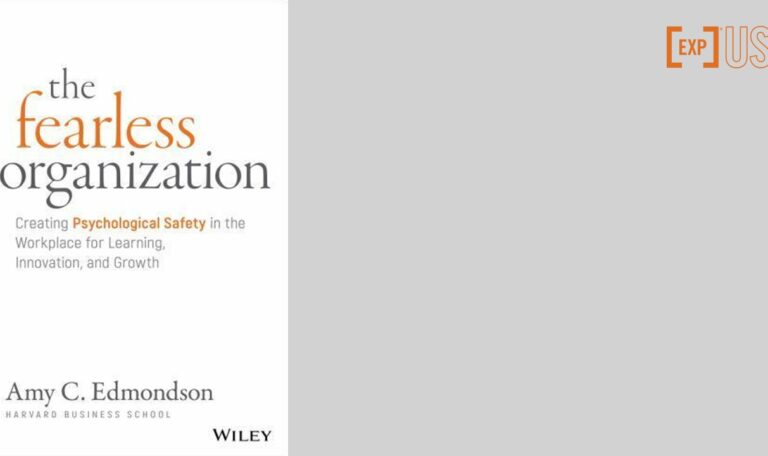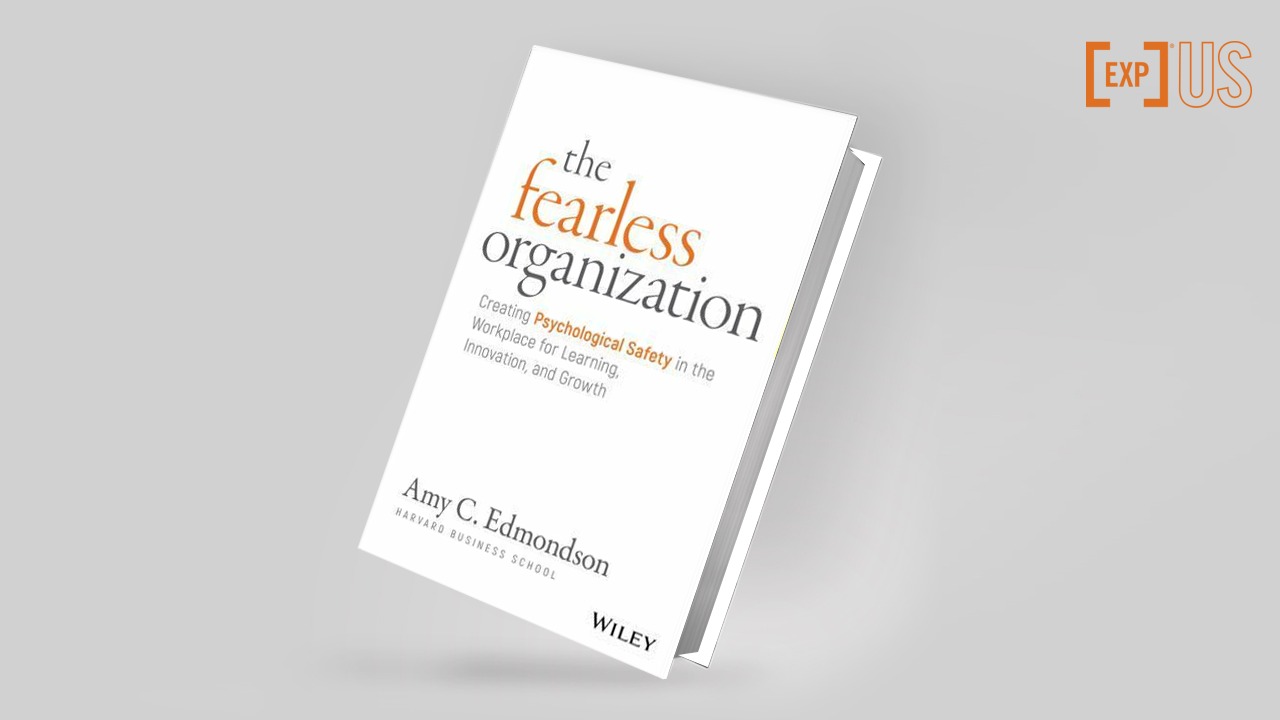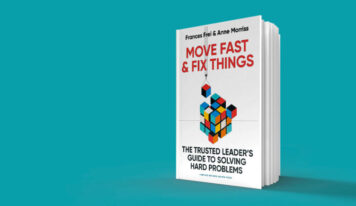Central Ideas:
1 – Neuroscience research shows that fear consumes physiological resources, diverting them from parts of the brain that control working memory and process new information. This is the reason why it is hard for people to work better when they are afraid.
2 – Like Volkswagen, the avoidable failure of Wells Cargo was not the result of a bad apple, but of a system that required achieving ambitious goals that could only be achieved by lying. Employees worked under a culture of fear that did not tolerate dissent.
3 – Pixar co-founder Ed Catmull credits the studio’s success, in part, to candor. His definition of candor as sincerity or honesty and his view that the word “candor” is associated with truth-telling and the absence of reservations support the premises of psychological safety.
4 – Cynthia Carroll took over South Africa’s Anglo-American mining company in 2007. Shocked by the number of fatalities, 200 in five years, she reworked the entire safety policy, discussing it directly with the workers, which resulted in a climate of psychological safety and growth.
5 – Psychological safety is best thought of as a facilitator that allows other success factors, such as motivation, trust, or diversity, to have the desired effects on work outcomes.
About the author:
Amy C. Edmondson is a professor of management leadership at Harvard Business School. Recognized by the biennial Thinkers 50 ranking of management thinkers since 2011, she teaches and writes about leadership, teams, and organizational learning. She is the author of Teaming: How Organizations Learn, Innovate and Compete in the Knowledge Economy.
Introduction
My field research base was primarily focused on groups and teams, because that shows how most jobs are done. Few products or services today are created by individuals acting alone, few individuals simply do their job and then turn the output over to other people to do the next step in a linear, sequential way. On the contrary, many jobs require people to talk to each other to solve changing interdependencies. Almost everything we value in the modern economy is the result of decisions and actions that are interdependent, and therefore the consequence of effective teamwork.
Over time, I accidentally stumbled upon the importance of psychological safety. As I will explain in Chapter 1, this launched me into a new research program that ultimately provided empirical evidence that validates the ideas developed and presented in this book.
For now, let’s just say that I did not intend to study psychological safety, but rather to study the work team and its relationship to errors. I thought that the fact that people work together was an important element that brought learning to organizations in a world of change. Psychological safety unexpectedly showed – in what was later found to be a blinding flash of the obvious – the explanation for some surprising results in my data.
Today, studies on psychological safety can be found in sectors ranging from administration and health services to elementary school training. In the last twenty years, a growing literature has taken shape on the causes and consequences of psychological safety in the workplace. Some of it is my own work, but much of it has been done by other researchers. We have learned a lot about what it is, how it works, and why psychological safety matters.
PART I – The Power of Psychological Safety
Chapter 1 – The Foundation
In other words, no one wakes up in the morning excited to go to work and looks ignorant, incompetent, or unpleasant. These are the so-called interpersonal risks, and they are what almost everyone seeks to avoid, not always consciously.
In fact, many of us try to appear intelligent, capable, or useful in the eyes of others. It doesn’t matter what your line of work, situation, or gender is. We all learn how to manage interpersonal risks relatively early in life.
At some point during elementary school, children begin to recognize that what others think about them matters and learn how to lessen the risk of rejection or contempt. When we are adults, we are usually very good at this; so good that we do it without conscious thought. Don’t want to appear ignorant? Don’t ask questions. Don’t want to appear incompetent? Don’t admit mistakes or weaknesses. Don’t want to appear unpleasant? Don’t make suggestions.
Fear inhibits learning. Neuroscience research shows that fear consumes physiological resources, diverting them away from parts of the brain that control working memory and process new information. This impairs analytical thinking, creative insight, and problem-solving.
This is the reason why it is difficult for people to work better when they are afraid. As a result, how psychologically safe a person feels shapes the predisposition to engage in learning behaviors, such as sharing information, asking for help, or experimenting. And it also affects employee satisfaction.
Hierarchy (or, more specifically, the fear created when it is not handled well) reduces psychological safety. Research shows that lower-level team members generally feel less secure than higher-level team members. Research also shows that we are constantly evaluating our relative status, monitoring how we might pit ourselves against others, and usually unconsciously. Furthermore, those at lower hierarchical levels experience stress in the presence of those at higher levels.
Psychological safety describes a belief that neither formal nor informal consequences of interpersonal risks, such as asking for help or admitting fault, will be punitive. In psychologically safe environments, people believe that if they make a mistake or ask for help, others will not react negatively.
On the contrary, sincerity is both allowed and expected. In short, psychological safety describes a climate in which people feel safe enough to take interpersonal risks by speaking up and sharing concerns, questions, or ideas. When people do not speak up, the organization’s ability to innovate and grow is threatened.
Chapter 2 – The Audit
In today’s organizations, psychological safety is not something “nice to have.” It is not an employee benefit, like free lunch or a game room, that you should worry about to keep people happy at work.
In contrast, I will argue that psychological safety is essential to unleashing talent and value creation. Hiring talent is simply not enough anymore. People need to be in workplaces where they feel able and willing to use their talent.
In any organization that requires knowledge – and especially one that requires integrated knowledge from multiple areas of expertise – psychological safety is a requirement for success.
In short, when companies rely on knowledge and collaboration for innovation and growth, whether or not to invest in building a psychologically safe climate is no longer a choice.
Silence epidemic. Chances are you’ve experienced a time at work when you didn’t ask a question you really wanted to ask, or when you wanted to give an idea but instead stayed quiet. Several studies show that these kinds of silences are painfully common.
By collecting and analyzing data from interviews with adult employees, studies have investigated when and why people feel unable to express themselves openly in the workplace. From this study, we learned first and foremost that people often hold back, even when they believe that what they have to say could be important to the organization, the customer, and themselves.
In the first study on silence in the workplace, New York University research managers Frances Miliken, Elizabeth Morrison, and Patricia Hewlin interviewed 40 full-time employees working in financial services consulting, media, pharmaceutical, and advertising to understand why these employees were unable to express themselves openly at work and what topics they were most frequently unable to address.
When pressed to explain why they remained silent, they often said they didn’t want to be badmouthed. Another common reason was not wanting to embarrass or upset someone. Still, others expressed a sense of futility – something like “it won’t matter anyway, why bother?” A few mentioned fear of retaliation. But the two most frequently mentioned reasons for remaining silent were, first, fear of being seen or labeled negatively, and second, fear of damaging work relationships. These fears, which are by definition the opposite of psychological safety, have no place in a fearless organization.
A growing body of studies shows that psychological safety can exist at work, and when it does, people actually talk openly, offer ideas, report mistakes, and exhibit much more of what we might categorize as “learning behavior.”
For example, in a study of nurses in four Belgian hospitals, a team of researchers led by Hannes Leroy explored how head nurses encouraged other nurses to report errors, while also reinforcing high safety standards. Here, the challenge is to ask people to perform the highest quality (possibly error-free) work and yet be willing to talk about errors that may occur.
Leroy and his colleague surveyed nurses in 54 departments, measuring a set of interrelated factors: psychological safety, error reporting, the number of errors made, nurses’ opinions about how much the department prioritized patient safety, and whether the head nurse practiced safety protocols.
Leroy found that the groups with higher psychological safety reported more errors to the head nurses. This finding was consistent with what I had seen in college in my study of medication errors. More interestingly, they found that when nurses thought patient safety was a high priority in the department and when psychological safety was high, fewer errors were made. In contrast, when psychological safety was low, despite belief in the department’s stated commitment to patient safety, employees made more errors. In short, the psychologically safe staff made fewer errors and talked openly about them more often.
Fortunately, data showed that psychologically safe staff were also high performers – a result that held across both types of performance measures.
Researchers Markus Baer and Michael Frese took this to the next level of analysis, showing that psychological safety increased firm performance in a sample of 47 medium-sized German firms in both industrial and service sectors.
Performance was measured in two ways: longitudinal change in return on assets (controlling for a prior constant return on assets) and executive assessments of achievement of firm goals.
All companies were committed to innovation processes. But innovation process efforts only led to high performance when the organization had psychological security.
In summary, the innovation process can be a good way to boost company performance, but a psychologically safe environment helps to pay off the investment.
It seemed that there was no answer to the question of why some teams thrive and others fail. So, as Duhiggs wrote, “when Rozovsky and his colleagues at Google found the concept of psychological safety in academic papers, it was as if everything suddenly fell into place. What they found was that even extremely intelligent and highly capable Google employees needed a psychologically safe work environment to contribute the skills they had to offer.
The team also found four other factors that helped explain team performance – clear goals, trusted colleagues, individually relevant work, and a belief that work has an impact.
As Rozovsky put it, however, reiterating the quote from the beginning of Chapter 1, “psychological safety was by far the most important…it was the foundation of the other four.”
PART II – Psychological safety at work
Chapter 3 – Avoidable Failure
As the saying goes, pride comes before the downfall. Only a year earlier, Volkswagen (VW), the world’s largest automotive company, was facing an unimaginable scandal. The clean diesel engines that anchored the impressive sales in the US were discovered to be – essentially – a hoax. German agents raided the company’s headquarters in Wolfsburg, looking for incriminating evidence. Criminal investigations were opened by the United States and the European Union to find out who knew what, when, and how. The company halted sales, reported its first quarterly loss in 15 years, and witnessed a third of its value disappear. CEO Martin Winterkorn resigned in September 2015.
Writing shortly after VW’s collapse, Chrysler’s Bob Lutz speculated that Piech was “very likely the root cause of VW’s diesel emissions scandal” because he instigated “a reign of terror and a culture in which performance was driven by fear and intimidation.” Although perhaps in an extreme case, the fact is that many managers are sympathetic to using power to demand that people achieve certain goals.
On December 8, 2016, it was all over. The ticking time bomb had exploded from within, shattering the illusory queen of one-store matched sales. After being convicted of extensive improper sales practices in its banking division, Wells Cargo announced a $185 million settlement with the Consumer Financial Protection Bureau and two other regulatory agencies. CEO John Stumpf resigned the following month.
In the early 2000s, Wells Cargo adopted a tie-in sales campaign, called “Getting All Eight,” intended to motivate banks to sell, on average, an unprecedented eight products per customer. Bank employees who failed to meet sales targets were trained to increase their numbers, including “objection handling” training to coerce people into buying more products. If they still failed to meet their numbers, they were fired from the company. Employees in the banking division, in order to raise the sales estimate, opened two million unauthorized accounts.
Like Volkswagen, Wells Cargo’s avoidable failure was not the result of a bad apple, but of a system that required reaching goals so ambitious that they could only be achieved by lying. Employees worked under a culture of fear that did not tolerate dissent.
Chapter 4 – Dangerous Silence
For open speaking to become routine, psychological safety – and expectations about open speaking – must become institutionalized and systematized. After Tenerife [fatal collision of a KLM plane with a Pan Am plane], cabin training changed, giving way to more emphasis on crew decision-making, encouraging pilots to defend their opinion when they believed something was wrong, and helping captains listen to copilot and crew concerns. These measures were a precursor to the official crew resource management (GRTO) training that all pilots must undergo.
Cassandra, one of the most tragic characters in classical Greek mythology was given the gift of prophecy along with the curse that she would never be believed. Low levels of psychological safety can create a culture of silence. They can create a culture of Cassandra – an environment in which speaking openly is looked down upon and warnings are ignored. Especially when speaking openly involves drawing attention to unpleasant outcomes. As was the case with Cassandra in her war prophecy, it is not easy for others to hear or believe. So the culture of silence is not only one that inhibits speaking openly, but one in which people fail to listen carefully to those who speak openly – especially when they are bringing unpleasant news.
Consider the explosion of the space shuttle Challenger in 1986. In contrast to Rodney Rocha’s silence at a crucial moment at work, Roger Boisjoly, an engineer for the Morton-Thiokol contractor at NASA, spoke openly. The night before the disastrous launch, Boisjoly expressed his concern that extremely cold temperatures could cause the sealing rings connecting the shuttle segments to malfunction. His data was incomplete and his argument vague, but the assembled group could have readily resolved the vagueness with some simple analysis and experiments if they had listened to him in-depth and with respect. In short, for voice to be effective, a culture of listening is needed.
Chapter 5 – The Fearless Workplace
Pixar co-founder Ed Catmull credits the studio’s success, in part, to candor. His definition of candor as sincerity or honesty and his view that we associate the word “candor” with telling the truth and the absence of reservations backs up the premises of psychological safety.
When candor is part of the workplace culture, people don’t feel silenced. They don’t keep their thoughts to themselves. They say what’s on their mind and share ideas, opinions, and criticisms. Preferably they laugh together and talk effusively.
Catmull encourages openness by looking for ways to institutionalize it in the organization – more specifically, in what Pixar calls the “brain trust”.
The brain trust was launched in 1999 when Pixar was taking a risk to save Toy Story 2, which had gone off the rails. The recipe for brain trust is quite simple: a group of directors and storytellers watch the first screening of the film together, have lunch together, and then give feedback to the director about what they think worked and what didn’t work. But the main ingredient is candor.
In 1975, Ray Dalio, a man in his 20s, founded Bridgewater Associates in his two-bedroom apartment in New York City. Since then, the company has grown to more than 1,500 employees, consistently achieved high returns (even during the financial crisis of 2008-2009), and has been honored by dozens of industry awards. Dalio was among the 400 list in Forbes magazine and, in TIME magazine, among the 100 most influential people. He attributes Bridgewater’s success to its culture of “valuing meaningful work and relationships,” which it has achieved through “radical truth and transparency.” Dalio created a document entitled Principles, to record tested and approved ideas, methods, and processes that he would have developed.
The great recession of 2007-2009 presented a drastic opportunity for Barry-Wehmiller to honor its promise to care for people as family. When new equipment orders dropped considerably and layoffs seemed inevitable, Chapman initiated a program of shared sacrifice instead.
According to his principle that in a loving family “all family members would absorb some pain so that no family member would have to experience a drastic loss,” there would be no layoffs. In return, all employees, no matter their position, would take an unpaid four-week leave of their choice.
Cost-cutting in the form of shared sacrifice manifested itself in other ways as well. Chapman reduced his salary to $10,500, suspended executive bonuses, reduced travel expenses. In other words, by continuing to make its team members feel safe and cared for during a crisis, the company created a win-win situation for everyone.
Chapter 6 – Safe and Sound
The experienced crew of Flight 1549 [January 2000, landing in the Hudson River] were well trained in standard aviation equipment protocols and procedures. Equally important, they were trained in Threat and Error Management (GAE) and GRT (also sometimes called Crew Resource Management). Both programs teach ways of thinking and making decisions.
GRT – a program that, among other techniques, instructs aviation crews to talk openly with their captains when they feel something is wrong and, likewise, instructs captains to listen to crew concerns is especially well-suited to creating psychological safety environments.
GRT training, now mandatory for all pilots, first began in response to Tenerife and other similar tragic accidents, such as the 1982 fatal Air Florida landing at Potomac, where the copilot failed to insist that the captain return because of freezing rain and incomplete de-icing, and the 2013 Asiana Airlines crash at San Francisco airport when the copilot was afraid to warn his captain about a low-speed landing.
Kent Thiry refers to himself as the “mayor” of the “city” DaVita Renal Training and emphasizes that “building a successful company is a means to the end of building a healthy community.”
Also in support of a healthy community, the DaVita Village Network fund exists to help teammates who may encounter unexpected medical expenses or have other financial difficulties This is part of the “all for one” philosophy.
The company matches donations from teammates in the fund. Although most colleagues are low-skilled, hourly workers, DaVita offers benefits that cover health and welfare, including provisions for health care, retirement, tuition reimbursement, and, most surprisingly, stock options and profit-sharing.
Patients who feel comfortable and confident-psychologically secure-with the clinical team are more likely to comply with a rigorous treatment plan. To encourage these positive feelings, DaVita’s centers are often decorated with photographs of the patient and their family members, as well as drawings made by them, their children, and grandchildren.
During the lekgotla (talking circle) at Anglo American (South Africa’s largest mining company), the managers rephrased the initial question. Instead of asking workers to give their opinions directly about safety problems, they asked, “What do we need to do to create a caring and respectful work environment?”
It was then that workers began to feel safe enough to speak openly about specific concerns. One group said they would like hot water in the workplace for cleaning and for making tea (management complied with this request). The dialogue continued until each group had developed a contract indicating what specific actions were needed to maximize safety.
As Judy Ndlovu, an Anglo-American executive said of this process, “the real change was listening to the workers … Cynthia Carroll challenged management to understand what the employees were thinking, what they were feeling as they went into the mine every day.
Cynthia Carroll took over the Anglo American mining company in 2007 and was shocked by the number of fatalities occurring at the company: about 200 in the five years before she arrived. She remade the entire safety policy, but in dialogue with all the workers, temporarily halting mining activity and creating a psychological safety environment.
PART III – Creating an organization without fear
Chapter 7 – Making it happen
When Julie Morath arrived as chief operating officer at Children’s Hospital and Clinics in Minneapolis, Minnesotta, her goal was simple: 100% patient safety for the hospitalized children under her care. The goal may have been simple. With achieving it it was not. This was early 1999 and few people were talking about patient safety.
But when Morath began giving talks that elucidated hospital care as a complex, error-prone system, what she was doing was framing the work-or, more accurately, reshaping it. Her goal was to help people abandon the belief that incompetence (rather than complexity) was to blame. This shift in perspective would prove essential in helping people feel safe to talk openly about the problems, mistakes, and dangers they observed.
Morath reinforced her invitation to collaborate on several structural interventions. First, she created a core team called the Patient Orientation Committee (COSP) to lead the change initiative.
The COSP was developed as a multi-disciplinary, multi-level group to ensure that voices from across the hospital would be heard. Each member was invited with a personal statement as to why their perspective was requested.
Second, Morath and the COSP introduced a new policy called “blame-free reporting”-a system calling for confidential reports on risks and failures that people observed.
Third, as people began to feel safe enough to speak openly, Morath led more than 18 discussion groups to facilitate employees in all parts of the organization to share their concerns and experiences.
Failure is a valuable source of data, but leaders must understand and communicate that learning only happens when there is enough psychological safety to carefully investigate the lessons of failure.
In his book The Game-Changer, published while he was still CEO of Procter and Gamble, A. G. Lafley celebrates his eleven most costly product failures, describing why each one was valuable and what the company learned from each one. Recall, too, Ed Catmull’s confidence passed on to Pixar animators, whose movies always started out bad, to help them “separate fear and failure.”
The reframing shows that leaders have to establish and cultivate psychological safety to succeed in most work environments today. The leader is required to establish the direction of the work, ask for relevant collaborations to clarify and improve the overall direction that has been established, and create conditions for continuous learning to achieve excellence.
Cynthia Carroll reframed the work at Anglo American by actively asking for collaboration from the miners to devise new physical safety practices. Naohiro Masuda, the plant superintendent at Fukushima Daini, reframed work when he prepared a blackboard to effectively lead his team during a violent tsunami attack. He gave his team as much continuous information as he had available in a rapidly changing environment.
Chapter 8 – What’s Next?
Leadership is the power to make it possible for people and organizations to overcome inherent barriers to voice and commitment, as well as to gain emotional and concrete rewards from participating fully in an inspiring shared mission.
As noted in Chapter 7, leadership is not limited to the top of the organization, but can certainly be exercised at all levels. In essence, leadership is about harnessing the efforts of others to accomplish something that no one can accomplish alone. It is to help people go as far as they can with the talent and skills they have.
Hopefully, this book will convince, replacing silence with candor and fear with commitment are essential responsibilities for leaders today.
In the decade following the space shuttle Columbia mission, I used a powerful multimedia case study that my colleagues and I developed through public sources to teach in leadership programs at Harvard Business School and around the world.
One day in 2012, the phone in my office rang. To my surprise, the caller announced that it was from NASA. “We know what you are doing,” he said. As I gulped, he continued “and we think it’s excellent.” The caller was Ed Rogers, he was the director of knowledge at NASA’s Goddard Space Flight Center.
Rogers emphasized in our personal conversations that “communication is the key to our success” and that a “culture of listening” was as important as a culture of speaking openly, connecting our discussion in Chapter 4 about Roger Boisjoly’s unsuccessful efforts at speaking openly. “Communication involves transmitting and receiving,” he explained.
Roger called Christopher Scolese, the then-new director of NASA’s Goddard Space Flight Center, “the best leader I’ve ever worked for.” When I asked why he explained that it was because “he cares about people. He has a strategic perspective and cares about space and NASA” (as a whole, rather than favoring a particular institution). He went on to talk about how Scolese showed respect and interest in the contributions of others.
Helpful facilitator. I don’t see psychological security as a panacea. Far from it. Psychological security is only one of several factors necessary for success in the modern economy. As discussed in Chapter 2, psychological safety is best thought of as a facilitator that enables other factors, such as motivation, trust, or diversity, to have the desired effects on work outcomes. Psychological safety makes it possible for other drivers of success (talent, humility, diversity of thought) to be expressed in ways that influence how work gets done.
Is it possible to create psychological safety in any country?
Without a doubt, it is not easy to create a culture like Toyota’s – an approach to continuous improvement and perfect execution that relies on all employees, above and below in the hierarchy, to point out mistakes continuously, energetically, and willingly. But it’s worth it. Is this typical of Japanese culture? No. Is it deeply embedded in Toyota’s culture? Yes. In other words, it can be done.
Cultural differences in power distance mean that the job of creating psychological safety is more difficult in some countries than in others. Still, that doesn’t make it any less necessary.
If the work an organization does involve uncertainty, interdependence, or high stakes, success depends on creating some steps of psychological safety. Without a willingness to challenge a decision, organizations are in danger of avoidable failure, both large and small. So roll up your sleeves, you have work to do.
It may involve swimming against cultural forces, but it can be done. The good news is that, when done well, your efforts can create a powerful source of competitive advantage in a field where the average psychological security is low.
Review: Rogério H. Jönck
Images: Reproduction
FACTSHEET:

Title: The Fearless Organization – Creating Psychological Safety in the Workplace for Learning, Innovation and Growth.
Original Title: The Fearless Organization
![[Experience Club] US [Experience Club] US](https://experienceclubus.com/wp-content/uploads/2021/03/laksdh.png)










![[Experience Club] US [Experience Club] US](https://experienceclubus.com/wp-content/uploads/2021/03/logos_EXP_US-3.png)






![[EXP no SXSW 2024] Rohit Bhargava: como o pensamento não-óbvio pode melhorar o mundo](https://experienceclubus.com/wp-content/uploads/2024/03/rohit-356x206.jpg)
